Brand Management Report: Nestle's Strategies and Brand Equity Analysis
VerifiedAdded on 2021/01/01
|20
|5741
|140
Report
AI Summary
This report provides a comprehensive analysis of Nestle's brand management strategies. It begins with an introduction to brand management and brand equity, emphasizing their importance in achieving company standards. The report delves into Task 1, exploring the concepts of brand equity, brand building stages, the role of marketing, and strategies to strengthen brand equity, including brand extension, reinforcement, and revitalization. Task 2 analyzes Nestle's brand portfolio plan of action, including the BCG matrix. Task 3 evaluates Nestle's brand strengths, weaknesses, and potential collaborative agreements. Finally, Task 4 assesses the tools and techniques adopted by Nestle. The report concludes with an overview of branding's role in reinforcing brand equity and value. The report is enriched with models like Aaker's brand equity model.
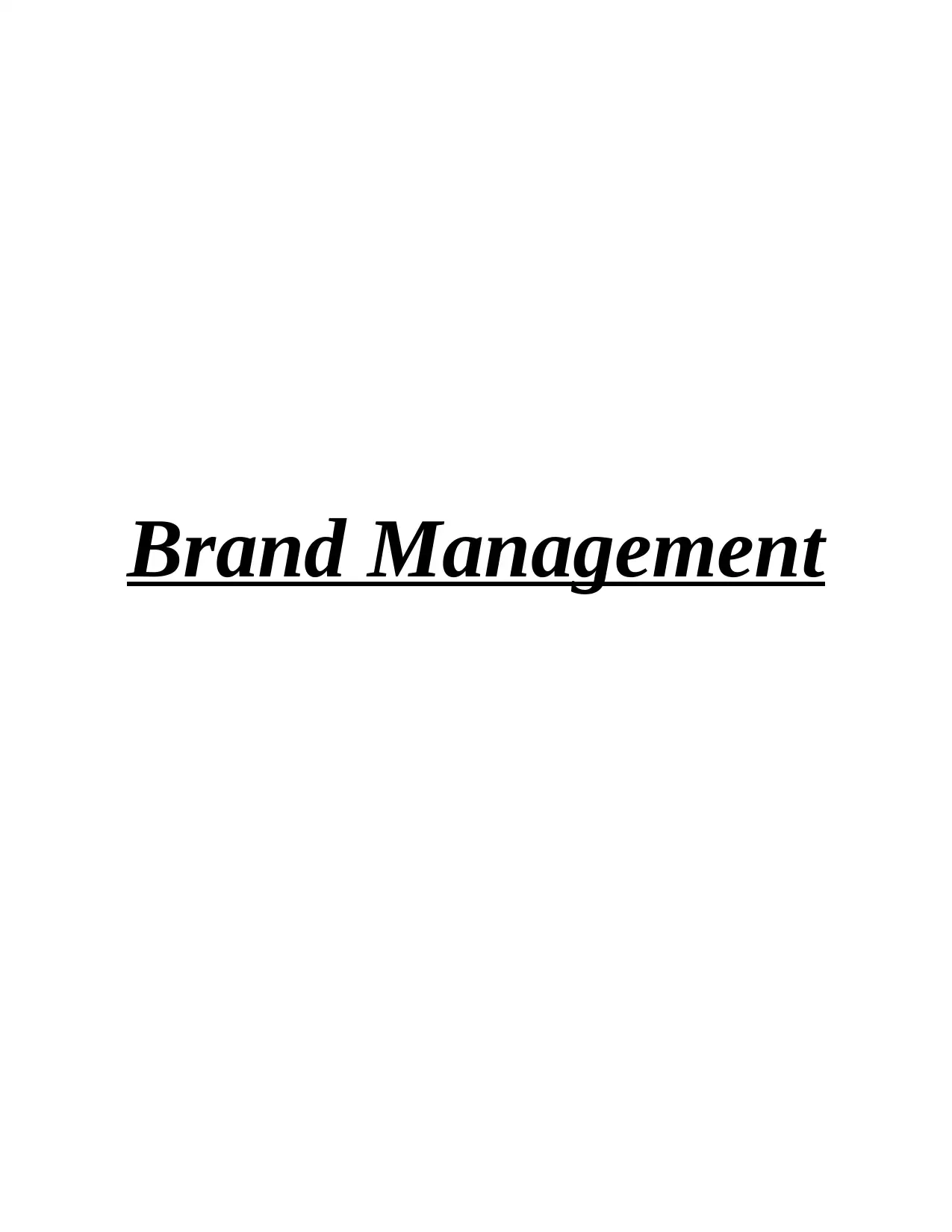
Brand Management
Paraphrase This Document
Need a fresh take? Get an instant paraphrase of this document with our AI Paraphraser
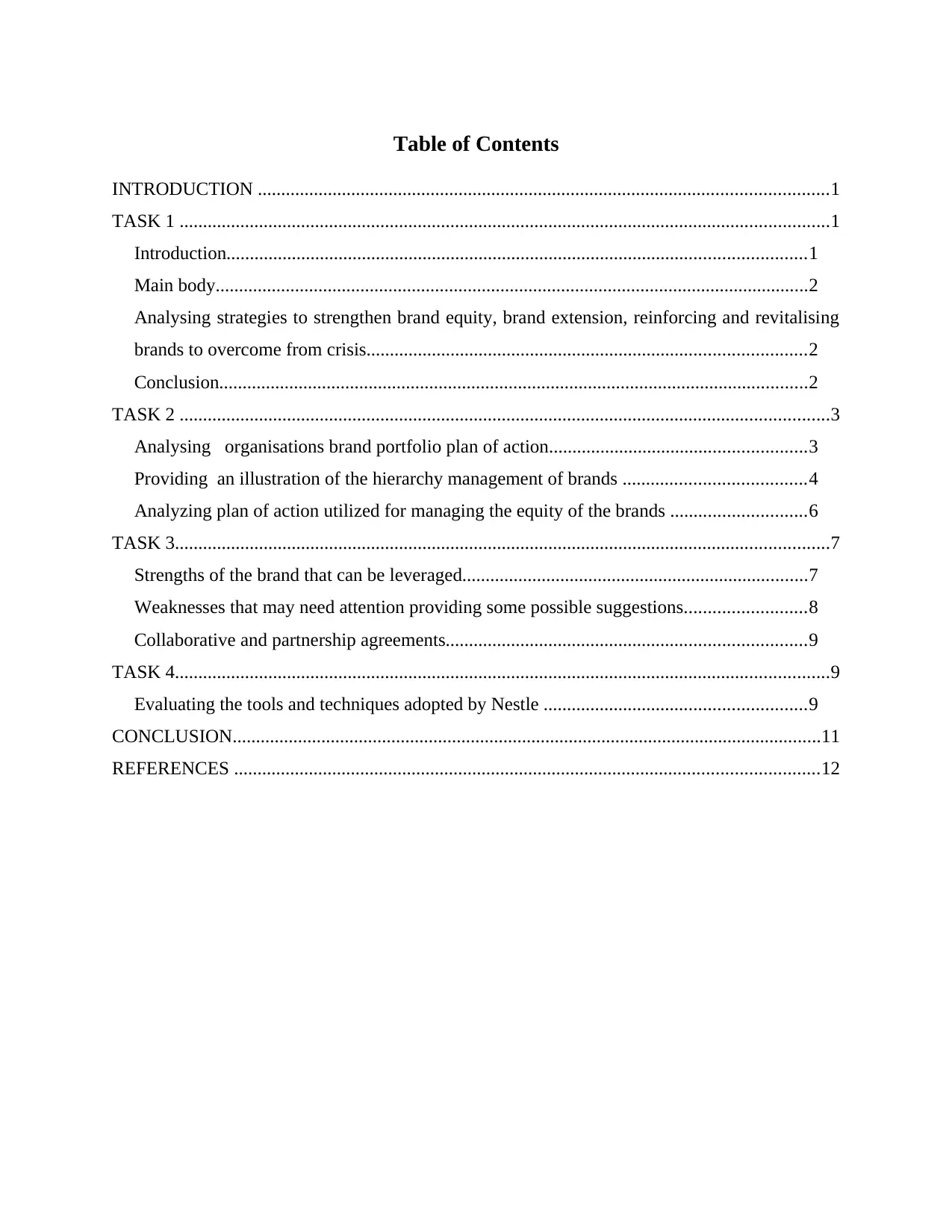
Table of Contents
INTRODUCTION ..........................................................................................................................1
TASK 1 ...........................................................................................................................................1
Introduction............................................................................................................................1
Main body...............................................................................................................................2
Analysing strategies to strengthen brand equity, brand extension, reinforcing and revitalising
brands to overcome from crisis..............................................................................................2
Conclusion..............................................................................................................................2
TASK 2 ...........................................................................................................................................3
Analysing organisations brand portfolio plan of action.......................................................3
Providing an illustration of the hierarchy management of brands .......................................4
Analyzing plan of action utilized for managing the equity of the brands .............................6
TASK 3............................................................................................................................................7
Strengths of the brand that can be leveraged..........................................................................7
Weaknesses that may need attention providing some possible suggestions..........................8
Collaborative and partnership agreements.............................................................................9
TASK 4............................................................................................................................................9
Evaluating the tools and techniques adopted by Nestle ........................................................9
CONCLUSION..............................................................................................................................11
REFERENCES .............................................................................................................................12
INTRODUCTION ..........................................................................................................................1
TASK 1 ...........................................................................................................................................1
Introduction............................................................................................................................1
Main body...............................................................................................................................2
Analysing strategies to strengthen brand equity, brand extension, reinforcing and revitalising
brands to overcome from crisis..............................................................................................2
Conclusion..............................................................................................................................2
TASK 2 ...........................................................................................................................................3
Analysing organisations brand portfolio plan of action.......................................................3
Providing an illustration of the hierarchy management of brands .......................................4
Analyzing plan of action utilized for managing the equity of the brands .............................6
TASK 3............................................................................................................................................7
Strengths of the brand that can be leveraged..........................................................................7
Weaknesses that may need attention providing some possible suggestions..........................8
Collaborative and partnership agreements.............................................................................9
TASK 4............................................................................................................................................9
Evaluating the tools and techniques adopted by Nestle ........................................................9
CONCLUSION..............................................................................................................................11
REFERENCES .............................................................................................................................12

⊘ This is a preview!⊘
Do you want full access?
Subscribe today to unlock all pages.

Trusted by 1+ million students worldwide
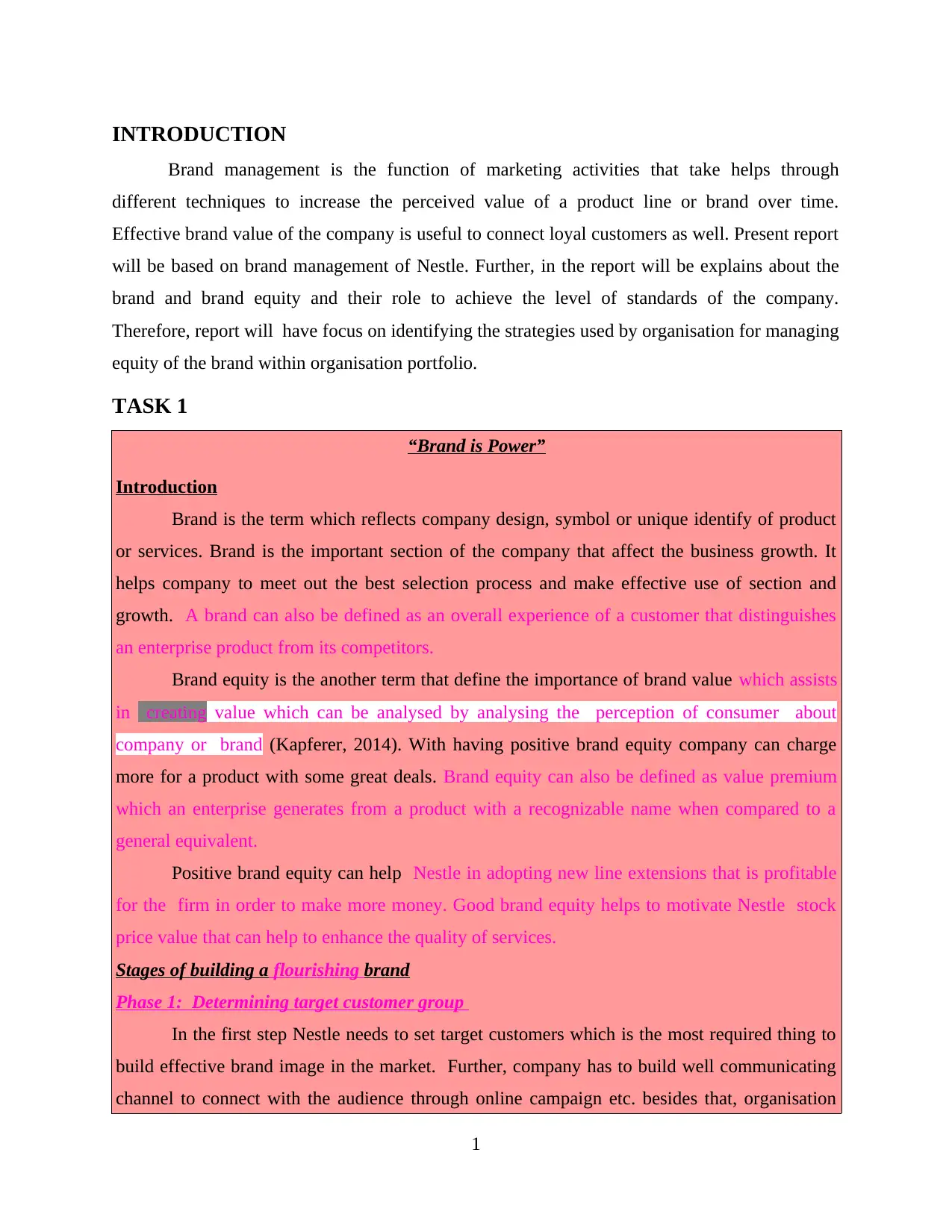
INTRODUCTION
Brand management is the function of marketing activities that take helps through
different techniques to increase the perceived value of a product line or brand over time.
Effective brand value of the company is useful to connect loyal customers as well. Present report
will be based on brand management of Nestle. Further, in the report will be explains about the
brand and brand equity and their role to achieve the level of standards of the company.
Therefore, report will have focus on identifying the strategies used by organisation for managing
equity of the brand within organisation portfolio.
TASK 1
“Brand is Power”
Introduction
Brand is the term which reflects company design, symbol or unique identify of product
or services. Brand is the important section of the company that affect the business growth. It
helps company to meet out the best selection process and make effective use of section and
growth. A brand can also be defined as an overall experience of a customer that distinguishes
an enterprise product from its competitors.
Brand equity is the another term that define the importance of brand value which assists
in creating value which can be analysed by analysing the perception of consumer about
company or brand (Kapferer, 2014). With having positive brand equity company can charge
more for a product with some great deals. Brand equity can also be defined as value premium
which an enterprise generates from a product with a recognizable name when compared to a
general equivalent.
Positive brand equity can help Nestle in adopting new line extensions that is profitable
for the firm in order to make more money. Good brand equity helps to motivate Nestle stock
price value that can help to enhance the quality of services.
Stages of building a flourishing brand
Phase 1: Determining target customer group
In the first step Nestle needs to set target customers which is the most required thing to
build effective brand image in the market. Further, company has to build well communicating
channel to connect with the audience through online campaign etc. besides that, organisation
1
Brand management is the function of marketing activities that take helps through
different techniques to increase the perceived value of a product line or brand over time.
Effective brand value of the company is useful to connect loyal customers as well. Present report
will be based on brand management of Nestle. Further, in the report will be explains about the
brand and brand equity and their role to achieve the level of standards of the company.
Therefore, report will have focus on identifying the strategies used by organisation for managing
equity of the brand within organisation portfolio.
TASK 1
“Brand is Power”
Introduction
Brand is the term which reflects company design, symbol or unique identify of product
or services. Brand is the important section of the company that affect the business growth. It
helps company to meet out the best selection process and make effective use of section and
growth. A brand can also be defined as an overall experience of a customer that distinguishes
an enterprise product from its competitors.
Brand equity is the another term that define the importance of brand value which assists
in creating value which can be analysed by analysing the perception of consumer about
company or brand (Kapferer, 2014). With having positive brand equity company can charge
more for a product with some great deals. Brand equity can also be defined as value premium
which an enterprise generates from a product with a recognizable name when compared to a
general equivalent.
Positive brand equity can help Nestle in adopting new line extensions that is profitable
for the firm in order to make more money. Good brand equity helps to motivate Nestle stock
price value that can help to enhance the quality of services.
Stages of building a flourishing brand
Phase 1: Determining target customer group
In the first step Nestle needs to set target customers which is the most required thing to
build effective brand image in the market. Further, company has to build well communicating
channel to connect with the audience through online campaign etc. besides that, organisation
1
Paraphrase This Document
Need a fresh take? Get an instant paraphrase of this document with our AI Paraphraser
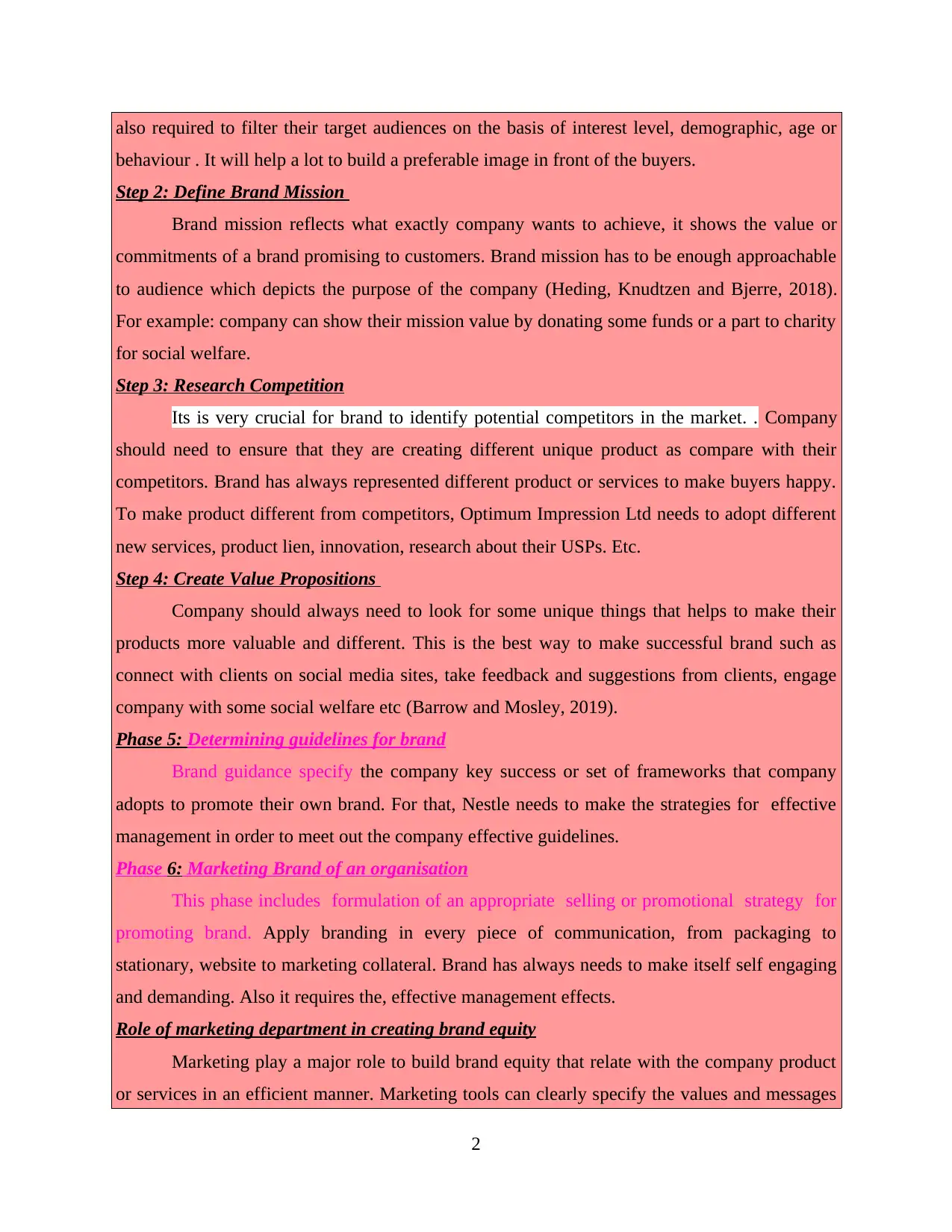
also required to filter their target audiences on the basis of interest level, demographic, age or
behaviour . It will help a lot to build a preferable image in front of the buyers.
Step 2: Define Brand Mission
Brand mission reflects what exactly company wants to achieve, it shows the value or
commitments of a brand promising to customers. Brand mission has to be enough approachable
to audience which depicts the purpose of the company (Heding, Knudtzen and Bjerre, 2018).
For example: company can show their mission value by donating some funds or a part to charity
for social welfare.
Step 3: Research Competition
Its is very crucial for brand to identify potential competitors in the market. . Company
should need to ensure that they are creating different unique product as compare with their
competitors. Brand has always represented different product or services to make buyers happy.
To make product different from competitors, Optimum Impression Ltd needs to adopt different
new services, product lien, innovation, research about their USPs. Etc.
Step 4: Create Value Propositions
Company should always need to look for some unique things that helps to make their
products more valuable and different. This is the best way to make successful brand such as
connect with clients on social media sites, take feedback and suggestions from clients, engage
company with some social welfare etc (Barrow and Mosley, 2019).
Phase 5: Determining guidelines for brand
Brand guidance specify the company key success or set of frameworks that company
adopts to promote their own brand. For that, Nestle needs to make the strategies for effective
management in order to meet out the company effective guidelines.
Phase 6: Marketing Brand of an organisation
This phase includes formulation of an appropriate selling or promotional strategy for
promoting brand. Apply branding in every piece of communication, from packaging to
stationary, website to marketing collateral. Brand has always needs to make itself self engaging
and demanding. Also it requires the, effective management effects.
Role of marketing department in creating brand equity
Marketing play a major role to build brand equity that relate with the company product
or services in an efficient manner. Marketing tools can clearly specify the values and messages
2
behaviour . It will help a lot to build a preferable image in front of the buyers.
Step 2: Define Brand Mission
Brand mission reflects what exactly company wants to achieve, it shows the value or
commitments of a brand promising to customers. Brand mission has to be enough approachable
to audience which depicts the purpose of the company (Heding, Knudtzen and Bjerre, 2018).
For example: company can show their mission value by donating some funds or a part to charity
for social welfare.
Step 3: Research Competition
Its is very crucial for brand to identify potential competitors in the market. . Company
should need to ensure that they are creating different unique product as compare with their
competitors. Brand has always represented different product or services to make buyers happy.
To make product different from competitors, Optimum Impression Ltd needs to adopt different
new services, product lien, innovation, research about their USPs. Etc.
Step 4: Create Value Propositions
Company should always need to look for some unique things that helps to make their
products more valuable and different. This is the best way to make successful brand such as
connect with clients on social media sites, take feedback and suggestions from clients, engage
company with some social welfare etc (Barrow and Mosley, 2019).
Phase 5: Determining guidelines for brand
Brand guidance specify the company key success or set of frameworks that company
adopts to promote their own brand. For that, Nestle needs to make the strategies for effective
management in order to meet out the company effective guidelines.
Phase 6: Marketing Brand of an organisation
This phase includes formulation of an appropriate selling or promotional strategy for
promoting brand. Apply branding in every piece of communication, from packaging to
stationary, website to marketing collateral. Brand has always needs to make itself self engaging
and demanding. Also it requires the, effective management effects.
Role of marketing department in creating brand equity
Marketing play a major role to build brand equity that relate with the company product
or services in an efficient manner. Marketing tools can clearly specify the values and messages
2
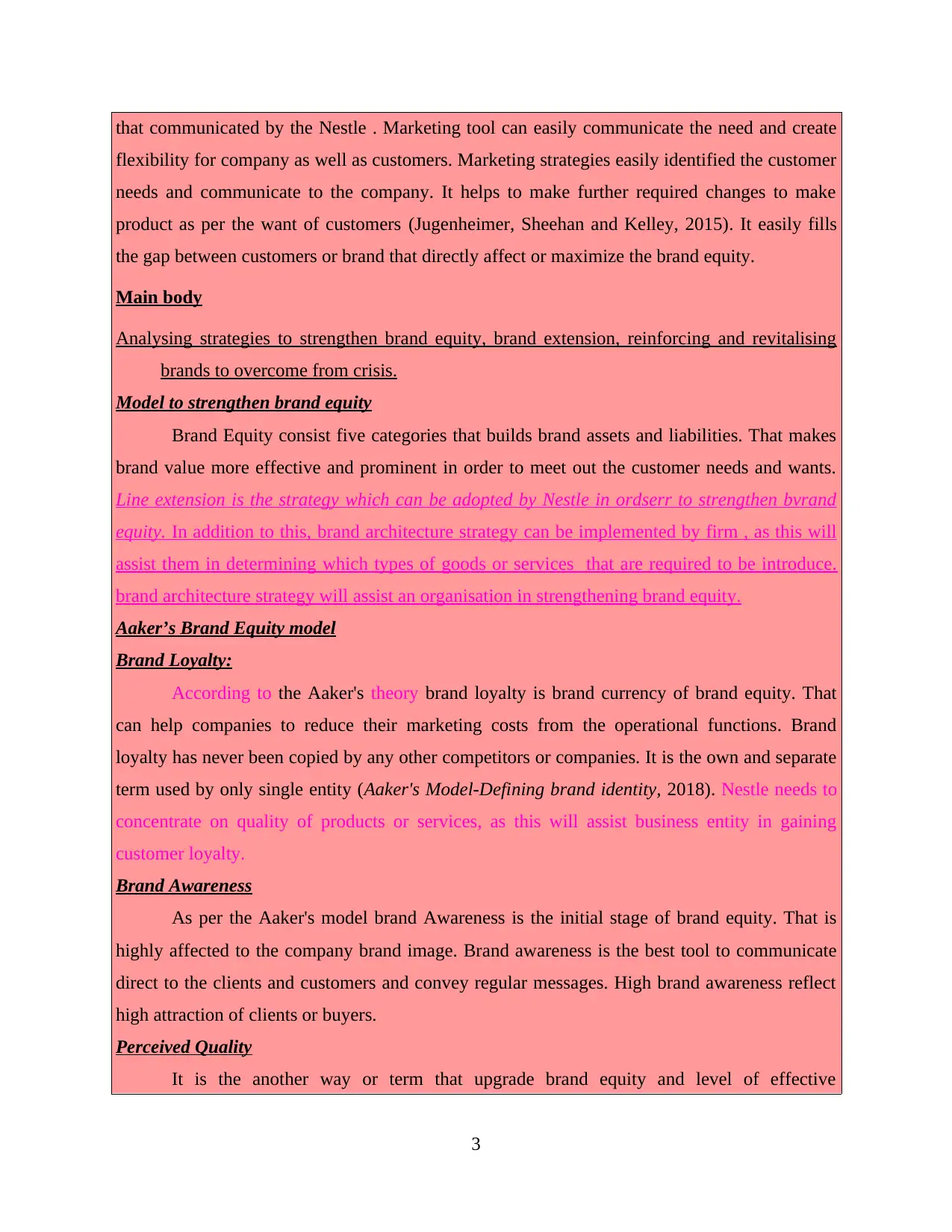
that communicated by the Nestle . Marketing tool can easily communicate the need and create
flexibility for company as well as customers. Marketing strategies easily identified the customer
needs and communicate to the company. It helps to make further required changes to make
product as per the want of customers (Jugenheimer, Sheehan and Kelley, 2015). It easily fills
the gap between customers or brand that directly affect or maximize the brand equity.
Main body
Analysing strategies to strengthen brand equity, brand extension, reinforcing and revitalising
brands to overcome from crisis.
Model to strengthen brand equity
Brand Equity consist five categories that builds brand assets and liabilities. That makes
brand value more effective and prominent in order to meet out the customer needs and wants.
Line extension is the strategy which can be adopted by Nestle in ordserr to strengthen bvrand
equity. In addition to this, brand architecture strategy can be implemented by firm , as this will
assist them in determining which types of goods or services that are required to be introduce.
brand architecture strategy will assist an organisation in strengthening brand equity.
Aaker’s Brand Equity model
Brand Loyalty:
According to the Aaker's theory brand loyalty is brand currency of brand equity. That
can help companies to reduce their marketing costs from the operational functions. Brand
loyalty has never been copied by any other competitors or companies. It is the own and separate
term used by only single entity (Aaker's Model-Defining brand identity, 2018). Nestle needs to
concentrate on quality of products or services, as this will assist business entity in gaining
customer loyalty.
Brand Awareness
As per the Aaker's model brand Awareness is the initial stage of brand equity. That is
highly affected to the company brand image. Brand awareness is the best tool to communicate
direct to the clients and customers and convey regular messages. High brand awareness reflect
high attraction of clients or buyers.
Perceived Quality
It is the another way or term that upgrade brand equity and level of effective
3
flexibility for company as well as customers. Marketing strategies easily identified the customer
needs and communicate to the company. It helps to make further required changes to make
product as per the want of customers (Jugenheimer, Sheehan and Kelley, 2015). It easily fills
the gap between customers or brand that directly affect or maximize the brand equity.
Main body
Analysing strategies to strengthen brand equity, brand extension, reinforcing and revitalising
brands to overcome from crisis.
Model to strengthen brand equity
Brand Equity consist five categories that builds brand assets and liabilities. That makes
brand value more effective and prominent in order to meet out the customer needs and wants.
Line extension is the strategy which can be adopted by Nestle in ordserr to strengthen bvrand
equity. In addition to this, brand architecture strategy can be implemented by firm , as this will
assist them in determining which types of goods or services that are required to be introduce.
brand architecture strategy will assist an organisation in strengthening brand equity.
Aaker’s Brand Equity model
Brand Loyalty:
According to the Aaker's theory brand loyalty is brand currency of brand equity. That
can help companies to reduce their marketing costs from the operational functions. Brand
loyalty has never been copied by any other competitors or companies. It is the own and separate
term used by only single entity (Aaker's Model-Defining brand identity, 2018). Nestle needs to
concentrate on quality of products or services, as this will assist business entity in gaining
customer loyalty.
Brand Awareness
As per the Aaker's model brand Awareness is the initial stage of brand equity. That is
highly affected to the company brand image. Brand awareness is the best tool to communicate
direct to the clients and customers and convey regular messages. High brand awareness reflect
high attraction of clients or buyers.
Perceived Quality
It is the another way or term that upgrade brand equity and level of effective
3
⊘ This is a preview!⊘
Do you want full access?
Subscribe today to unlock all pages.

Trusted by 1+ million students worldwide
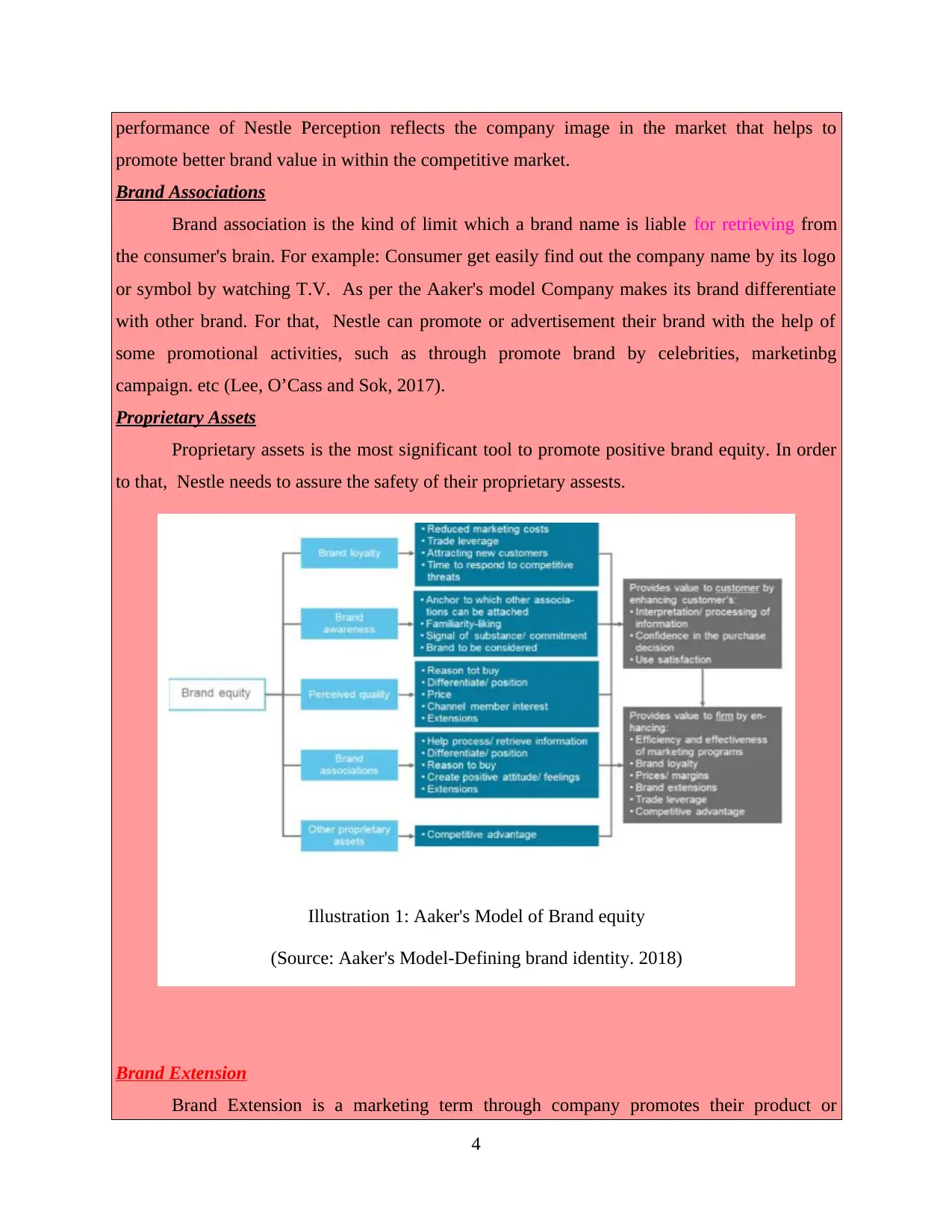
performance of Nestle Perception reflects the company image in the market that helps to
promote better brand value in within the competitive market.
Brand Associations
Brand association is the kind of limit which a brand name is liable for retrieving from
the consumer's brain. For example: Consumer get easily find out the company name by its logo
or symbol by watching T.V. As per the Aaker's model Company makes its brand differentiate
with other brand. For that, Nestle can promote or advertisement their brand with the help of
some promotional activities, such as through promote brand by celebrities, marketinbg
campaign. etc (Lee, O’Cass and Sok, 2017).
Proprietary Assets
Proprietary assets is the most significant tool to promote positive brand equity. In order
to that, Nestle needs to assure the safety of their proprietary assests.
Brand Extension
Brand Extension is a marketing term through company promotes their product or
4
Illustration 1: Aaker's Model of Brand equity
(Source: Aaker's Model-Defining brand identity. 2018)
promote better brand value in within the competitive market.
Brand Associations
Brand association is the kind of limit which a brand name is liable for retrieving from
the consumer's brain. For example: Consumer get easily find out the company name by its logo
or symbol by watching T.V. As per the Aaker's model Company makes its brand differentiate
with other brand. For that, Nestle can promote or advertisement their brand with the help of
some promotional activities, such as through promote brand by celebrities, marketinbg
campaign. etc (Lee, O’Cass and Sok, 2017).
Proprietary Assets
Proprietary assets is the most significant tool to promote positive brand equity. In order
to that, Nestle needs to assure the safety of their proprietary assests.
Brand Extension
Brand Extension is a marketing term through company promotes their product or
4
Illustration 1: Aaker's Model of Brand equity
(Source: Aaker's Model-Defining brand identity. 2018)
Paraphrase This Document
Need a fresh take? Get an instant paraphrase of this document with our AI Paraphraser
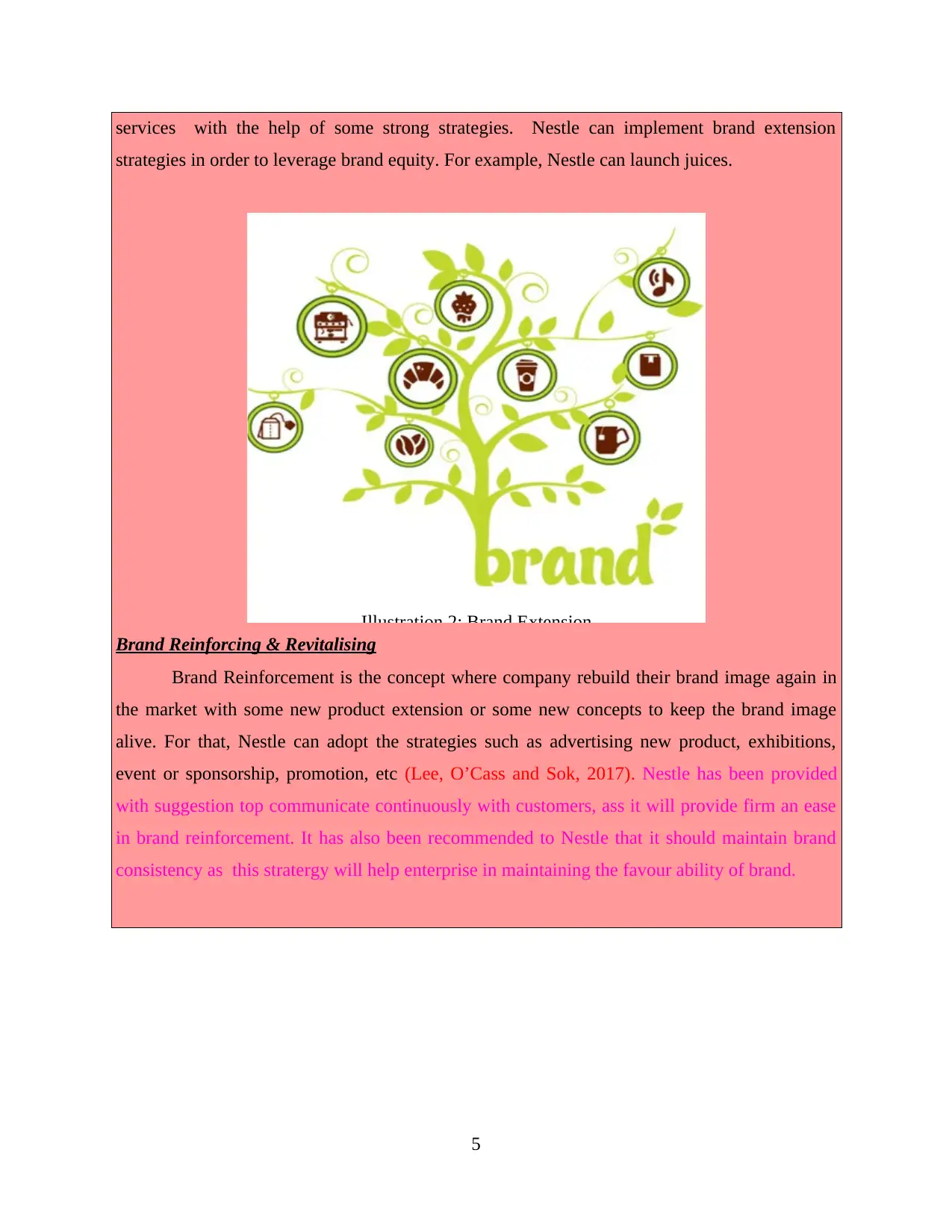
services with the help of some strong strategies. Nestle can implement brand extension
strategies in order to leverage brand equity. For example, Nestle can launch juices.
Brand Reinforcing & Revitalising
Brand Reinforcement is the concept where company rebuild their brand image again in
the market with some new product extension or some new concepts to keep the brand image
alive. For that, Nestle can adopt the strategies such as advertising new product, exhibitions,
event or sponsorship, promotion, etc (Lee, O’Cass and Sok, 2017). Nestle has been provided
with suggestion top communicate continuously with customers, ass it will provide firm an ease
in brand reinforcement. It has also been recommended to Nestle that it should maintain brand
consistency as this stratergy will help enterprise in maintaining the favour ability of brand.
5
Illustration 2: Brand Extension
strategies in order to leverage brand equity. For example, Nestle can launch juices.
Brand Reinforcing & Revitalising
Brand Reinforcement is the concept where company rebuild their brand image again in
the market with some new product extension or some new concepts to keep the brand image
alive. For that, Nestle can adopt the strategies such as advertising new product, exhibitions,
event or sponsorship, promotion, etc (Lee, O’Cass and Sok, 2017). Nestle has been provided
with suggestion top communicate continuously with customers, ass it will provide firm an ease
in brand reinforcement. It has also been recommended to Nestle that it should maintain brand
consistency as this stratergy will help enterprise in maintaining the favour ability of brand.
5
Illustration 2: Brand Extension
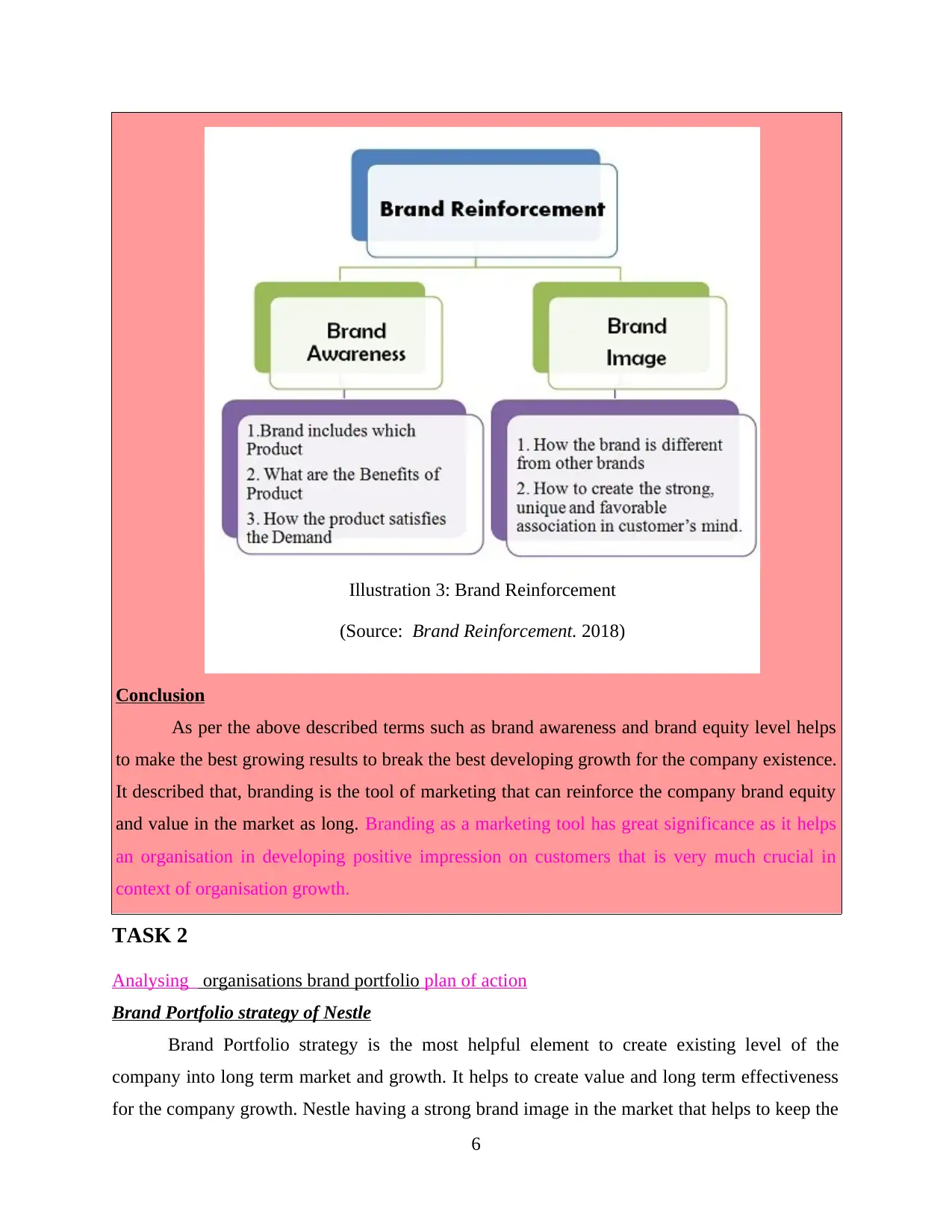
Conclusion
As per the above described terms such as brand awareness and brand equity level helps
to make the best growing results to break the best developing growth for the company existence.
It described that, branding is the tool of marketing that can reinforce the company brand equity
and value in the market as long. Branding as a marketing tool has great significance as it helps
an organisation in developing positive impression on customers that is very much crucial in
context of organisation growth.
TASK 2
Analysing organisations brand portfolio plan of action
Brand Portfolio strategy of Nestle
Brand Portfolio strategy is the most helpful element to create existing level of the
company into long term market and growth. It helps to create value and long term effectiveness
for the company growth. Nestle having a strong brand image in the market that helps to keep the
6
Illustration 3: Brand Reinforcement
(Source: Brand Reinforcement. 2018)
As per the above described terms such as brand awareness and brand equity level helps
to make the best growing results to break the best developing growth for the company existence.
It described that, branding is the tool of marketing that can reinforce the company brand equity
and value in the market as long. Branding as a marketing tool has great significance as it helps
an organisation in developing positive impression on customers that is very much crucial in
context of organisation growth.
TASK 2
Analysing organisations brand portfolio plan of action
Brand Portfolio strategy of Nestle
Brand Portfolio strategy is the most helpful element to create existing level of the
company into long term market and growth. It helps to create value and long term effectiveness
for the company growth. Nestle having a strong brand image in the market that helps to keep the
6
Illustration 3: Brand Reinforcement
(Source: Brand Reinforcement. 2018)
⊘ This is a preview!⊘
Do you want full access?
Subscribe today to unlock all pages.

Trusted by 1+ million students worldwide
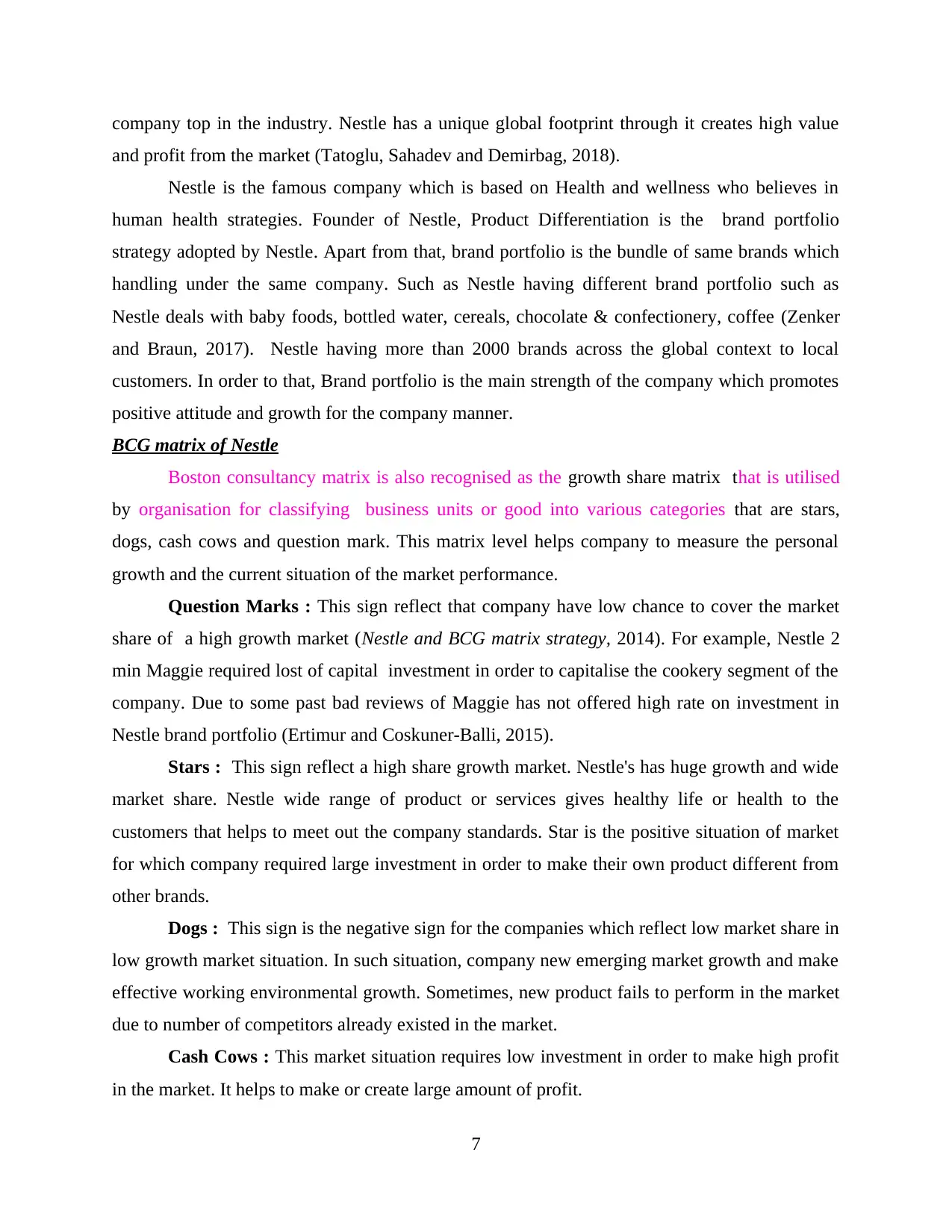
company top in the industry. Nestle has a unique global footprint through it creates high value
and profit from the market (Tatoglu, Sahadev and Demirbag, 2018).
Nestle is the famous company which is based on Health and wellness who believes in
human health strategies. Founder of Nestle, Product Differentiation is the brand portfolio
strategy adopted by Nestle. Apart from that, brand portfolio is the bundle of same brands which
handling under the same company. Such as Nestle having different brand portfolio such as
Nestle deals with baby foods, bottled water, cereals, chocolate & confectionery, coffee (Zenker
and Braun, 2017). Nestle having more than 2000 brands across the global context to local
customers. In order to that, Brand portfolio is the main strength of the company which promotes
positive attitude and growth for the company manner.
BCG matrix of Nestle
Boston consultancy matrix is also recognised as the growth share matrix that is utilised
by organisation for classifying business units or good into various categories that are stars,
dogs, cash cows and question mark. This matrix level helps company to measure the personal
growth and the current situation of the market performance.
Question Marks : This sign reflect that company have low chance to cover the market
share of a high growth market (Nestle and BCG matrix strategy, 2014). For example, Nestle 2
min Maggie required lost of capital investment in order to capitalise the cookery segment of the
company. Due to some past bad reviews of Maggie has not offered high rate on investment in
Nestle brand portfolio (Ertimur and Coskuner-Balli, 2015).
Stars : This sign reflect a high share growth market. Nestle's has huge growth and wide
market share. Nestle wide range of product or services gives healthy life or health to the
customers that helps to meet out the company standards. Star is the positive situation of market
for which company required large investment in order to make their own product different from
other brands.
Dogs : This sign is the negative sign for the companies which reflect low market share in
low growth market situation. In such situation, company new emerging market growth and make
effective working environmental growth. Sometimes, new product fails to perform in the market
due to number of competitors already existed in the market.
Cash Cows : This market situation requires low investment in order to make high profit
in the market. It helps to make or create large amount of profit.
7
and profit from the market (Tatoglu, Sahadev and Demirbag, 2018).
Nestle is the famous company which is based on Health and wellness who believes in
human health strategies. Founder of Nestle, Product Differentiation is the brand portfolio
strategy adopted by Nestle. Apart from that, brand portfolio is the bundle of same brands which
handling under the same company. Such as Nestle having different brand portfolio such as
Nestle deals with baby foods, bottled water, cereals, chocolate & confectionery, coffee (Zenker
and Braun, 2017). Nestle having more than 2000 brands across the global context to local
customers. In order to that, Brand portfolio is the main strength of the company which promotes
positive attitude and growth for the company manner.
BCG matrix of Nestle
Boston consultancy matrix is also recognised as the growth share matrix that is utilised
by organisation for classifying business units or good into various categories that are stars,
dogs, cash cows and question mark. This matrix level helps company to measure the personal
growth and the current situation of the market performance.
Question Marks : This sign reflect that company have low chance to cover the market
share of a high growth market (Nestle and BCG matrix strategy, 2014). For example, Nestle 2
min Maggie required lost of capital investment in order to capitalise the cookery segment of the
company. Due to some past bad reviews of Maggie has not offered high rate on investment in
Nestle brand portfolio (Ertimur and Coskuner-Balli, 2015).
Stars : This sign reflect a high share growth market. Nestle's has huge growth and wide
market share. Nestle wide range of product or services gives healthy life or health to the
customers that helps to meet out the company standards. Star is the positive situation of market
for which company required large investment in order to make their own product different from
other brands.
Dogs : This sign is the negative sign for the companies which reflect low market share in
low growth market situation. In such situation, company new emerging market growth and make
effective working environmental growth. Sometimes, new product fails to perform in the market
due to number of competitors already existed in the market.
Cash Cows : This market situation requires low investment in order to make high profit
in the market. It helps to make or create large amount of profit.
7
Paraphrase This Document
Need a fresh take? Get an instant paraphrase of this document with our AI Paraphraser
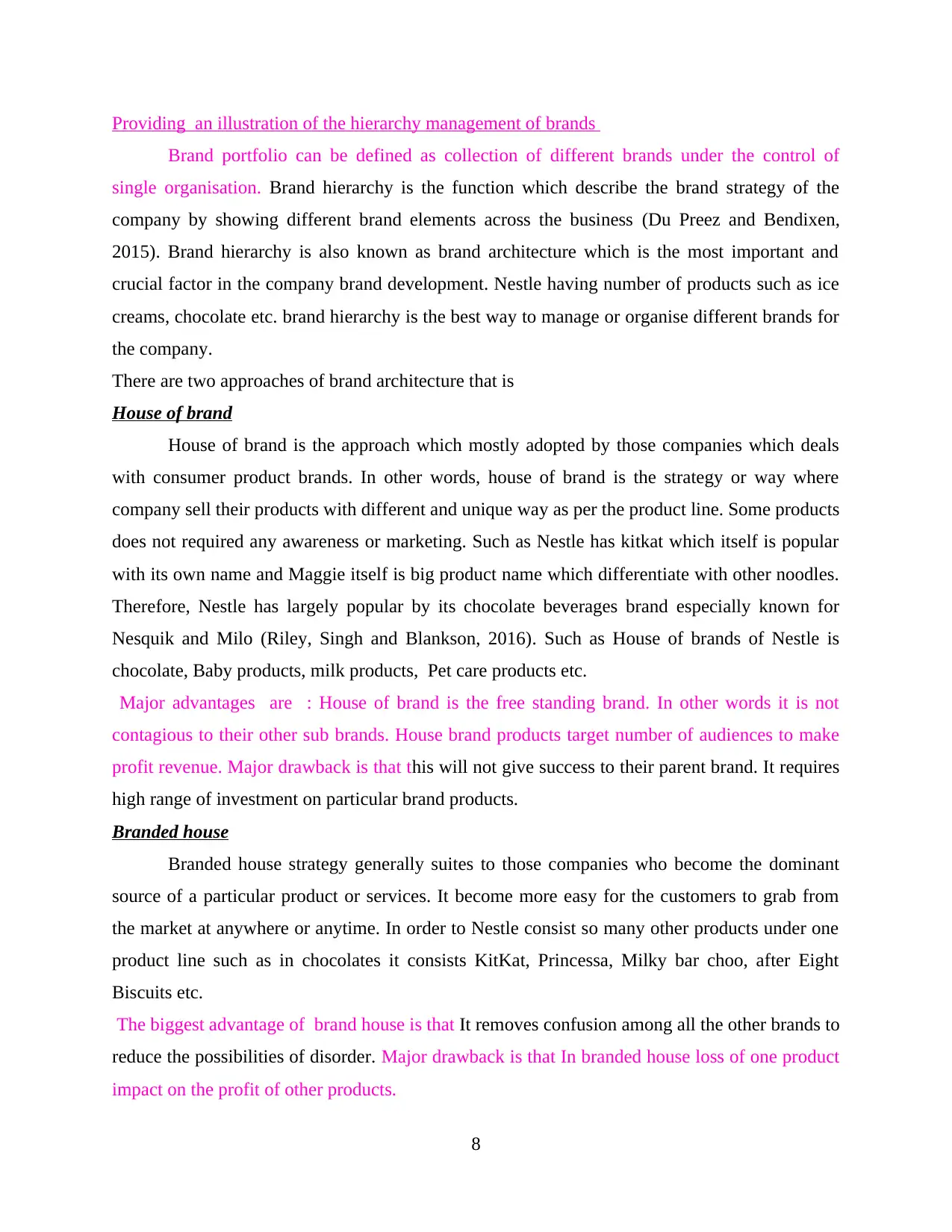
Providing an illustration of the hierarchy management of brands
Brand portfolio can be defined as collection of different brands under the control of
single organisation. Brand hierarchy is the function which describe the brand strategy of the
company by showing different brand elements across the business (Du Preez and Bendixen,
2015). Brand hierarchy is also known as brand architecture which is the most important and
crucial factor in the company brand development. Nestle having number of products such as ice
creams, chocolate etc. brand hierarchy is the best way to manage or organise different brands for
the company.
There are two approaches of brand architecture that is
House of brand
House of brand is the approach which mostly adopted by those companies which deals
with consumer product brands. In other words, house of brand is the strategy or way where
company sell their products with different and unique way as per the product line. Some products
does not required any awareness or marketing. Such as Nestle has kitkat which itself is popular
with its own name and Maggie itself is big product name which differentiate with other noodles.
Therefore, Nestle has largely popular by its chocolate beverages brand especially known for
Nesquik and Milo (Riley, Singh and Blankson, 2016). Such as House of brands of Nestle is
chocolate, Baby products, milk products, Pet care products etc.
Major advantages are : House of brand is the free standing brand. In other words it is not
contagious to their other sub brands. House brand products target number of audiences to make
profit revenue. Major drawback is that this will not give success to their parent brand. It requires
high range of investment on particular brand products.
Branded house
Branded house strategy generally suites to those companies who become the dominant
source of a particular product or services. It become more easy for the customers to grab from
the market at anywhere or anytime. In order to Nestle consist so many other products under one
product line such as in chocolates it consists KitKat, Princessa, Milky bar choo, after Eight
Biscuits etc.
The biggest advantage of brand house is that It removes confusion among all the other brands to
reduce the possibilities of disorder. Major drawback is that In branded house loss of one product
impact on the profit of other products.
8
Brand portfolio can be defined as collection of different brands under the control of
single organisation. Brand hierarchy is the function which describe the brand strategy of the
company by showing different brand elements across the business (Du Preez and Bendixen,
2015). Brand hierarchy is also known as brand architecture which is the most important and
crucial factor in the company brand development. Nestle having number of products such as ice
creams, chocolate etc. brand hierarchy is the best way to manage or organise different brands for
the company.
There are two approaches of brand architecture that is
House of brand
House of brand is the approach which mostly adopted by those companies which deals
with consumer product brands. In other words, house of brand is the strategy or way where
company sell their products with different and unique way as per the product line. Some products
does not required any awareness or marketing. Such as Nestle has kitkat which itself is popular
with its own name and Maggie itself is big product name which differentiate with other noodles.
Therefore, Nestle has largely popular by its chocolate beverages brand especially known for
Nesquik and Milo (Riley, Singh and Blankson, 2016). Such as House of brands of Nestle is
chocolate, Baby products, milk products, Pet care products etc.
Major advantages are : House of brand is the free standing brand. In other words it is not
contagious to their other sub brands. House brand products target number of audiences to make
profit revenue. Major drawback is that this will not give success to their parent brand. It requires
high range of investment on particular brand products.
Branded house
Branded house strategy generally suites to those companies who become the dominant
source of a particular product or services. It become more easy for the customers to grab from
the market at anywhere or anytime. In order to Nestle consist so many other products under one
product line such as in chocolates it consists KitKat, Princessa, Milky bar choo, after Eight
Biscuits etc.
The biggest advantage of brand house is that It removes confusion among all the other brands to
reduce the possibilities of disorder. Major drawback is that In branded house loss of one product
impact on the profit of other products.
8
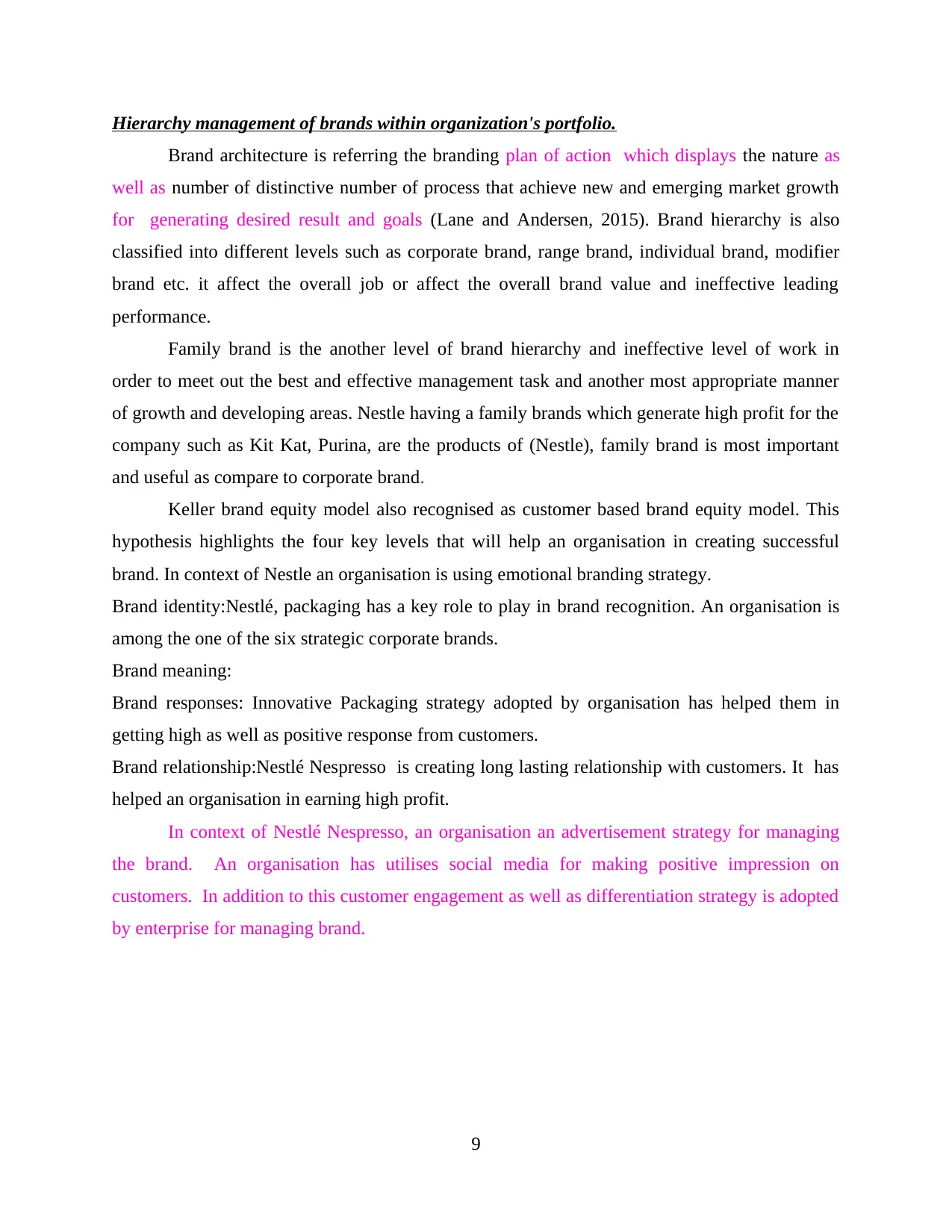
Hierarchy management of brands within organization's portfolio.
Brand architecture is referring the branding plan of action which displays the nature as
well as number of distinctive number of process that achieve new and emerging market growth
for generating desired result and goals (Lane and Andersen, 2015). Brand hierarchy is also
classified into different levels such as corporate brand, range brand, individual brand, modifier
brand etc. it affect the overall job or affect the overall brand value and ineffective leading
performance.
Family brand is the another level of brand hierarchy and ineffective level of work in
order to meet out the best and effective management task and another most appropriate manner
of growth and developing areas. Nestle having a family brands which generate high profit for the
company such as Kit Kat, Purina, are the products of (Nestle), family brand is most important
and useful as compare to corporate brand.
Keller brand equity model also recognised as customer based brand equity model. This
hypothesis highlights the four key levels that will help an organisation in creating successful
brand. In context of Nestle an organisation is using emotional branding strategy.
Brand identity:Nestlé, packaging has a key role to play in brand recognition. An organisation is
among the one of the six strategic corporate brands.
Brand meaning:
Brand responses: Innovative Packaging strategy adopted by organisation has helped them in
getting high as well as positive response from customers.
Brand relationship:Nestlé Nespresso is creating long lasting relationship with customers. It has
helped an organisation in earning high profit.
In context of Nestlé Nespresso, an organisation an advertisement strategy for managing
the brand. An organisation has utilises social media for making positive impression on
customers. In addition to this customer engagement as well as differentiation strategy is adopted
by enterprise for managing brand.
9
Brand architecture is referring the branding plan of action which displays the nature as
well as number of distinctive number of process that achieve new and emerging market growth
for generating desired result and goals (Lane and Andersen, 2015). Brand hierarchy is also
classified into different levels such as corporate brand, range brand, individual brand, modifier
brand etc. it affect the overall job or affect the overall brand value and ineffective leading
performance.
Family brand is the another level of brand hierarchy and ineffective level of work in
order to meet out the best and effective management task and another most appropriate manner
of growth and developing areas. Nestle having a family brands which generate high profit for the
company such as Kit Kat, Purina, are the products of (Nestle), family brand is most important
and useful as compare to corporate brand.
Keller brand equity model also recognised as customer based brand equity model. This
hypothesis highlights the four key levels that will help an organisation in creating successful
brand. In context of Nestle an organisation is using emotional branding strategy.
Brand identity:Nestlé, packaging has a key role to play in brand recognition. An organisation is
among the one of the six strategic corporate brands.
Brand meaning:
Brand responses: Innovative Packaging strategy adopted by organisation has helped them in
getting high as well as positive response from customers.
Brand relationship:Nestlé Nespresso is creating long lasting relationship with customers. It has
helped an organisation in earning high profit.
In context of Nestlé Nespresso, an organisation an advertisement strategy for managing
the brand. An organisation has utilises social media for making positive impression on
customers. In addition to this customer engagement as well as differentiation strategy is adopted
by enterprise for managing brand.
9
⊘ This is a preview!⊘
Do you want full access?
Subscribe today to unlock all pages.

Trusted by 1+ million students worldwide
1 out of 20
Related Documents
Your All-in-One AI-Powered Toolkit for Academic Success.
+13062052269
info@desklib.com
Available 24*7 on WhatsApp / Email
![[object Object]](/_next/static/media/star-bottom.7253800d.svg)
Unlock your academic potential
Copyright © 2020–2025 A2Z Services. All Rights Reserved. Developed and managed by ZUCOL.




